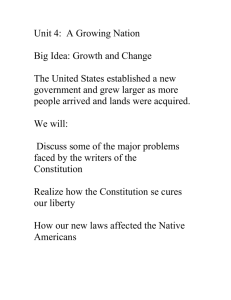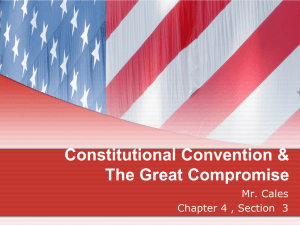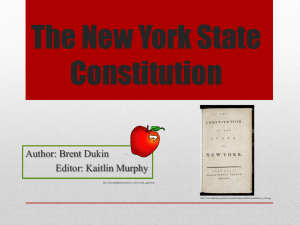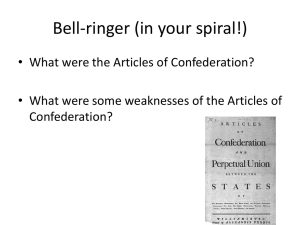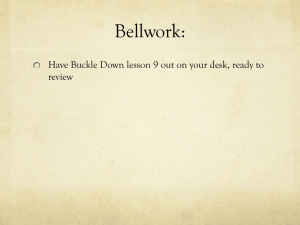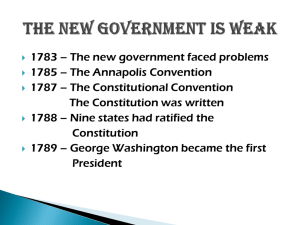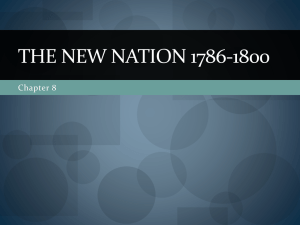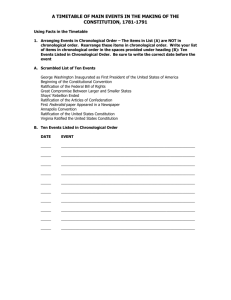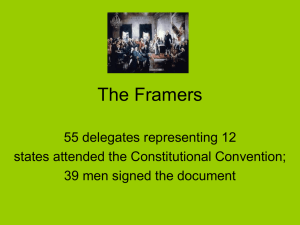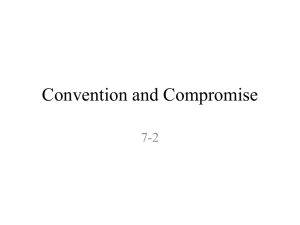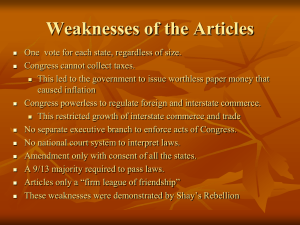Chapter 5, Section 2 Power Point
advertisement
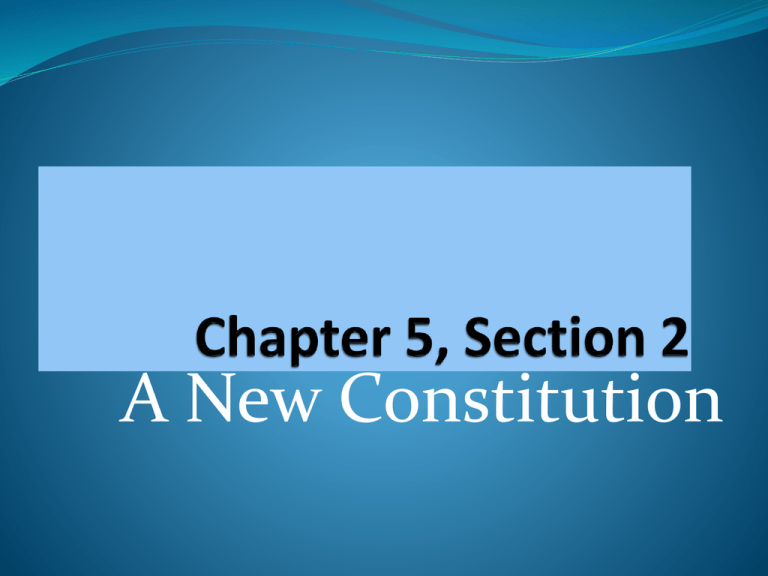
A New Constitution The Constitutional Convention What to do? Revise or Scrap the Articles? Nationalists wanted a strong 12 of 13 colonies sent central government: Washington, J. Adams, Franklin, Hamilton, Robert Morris, and James Madison very influential. 1786-Madison convinces Virginia to hold a convention to discuss problems with trade and taxation. Known as the Annapolis meeting, only five states “showed” up. Alexander Hamilton, NY, called for another convention to be held in Philadelphia in May 1787. delegates to the Philadelphia Convention which would later be known as the Constitutional Convention. All except R.I. 55 Heroes Shrewd Distinguished Lawyers (majority), planters, and merchants. Experienced politicians: 7 state governors 39 members of the Confederation Congress 8 signers of the Dec. of Ind. Thomas Jefferson, who was not there, was an ambassador to France, called it an “assembly of demigods.” Who’s Who George Washingtonpresiding officer Ben Franklin, at 81, oldest Alexander Hamilton Roger Sherman-Great Compromiser James Madison-record keeper-Later known as Father of the Constitution Meetings were closed to the public!!! Dueling Brains/Plans? Virginia Plan New Jersey Plan Edmund Randolph, VA William Paterson, NJ Scrap the Articles Modify the Articles (keep) Favored Large States Favored Small States 2 house legislature (bi- 1 (single) house legislature cameral)-both based on population New National government with power to make laws binding upon the states and power to tax (uni-cameral) Strong central government with power to raise taxes and to regulate trade Virginia vs. New Jersey Randolph vs. Paterson The Turning Point-The Connecticut Compromise a.k.a. The GREAT Compromise Small state versus large state and North versus South fighting threatened to end the Convention. Fighting continued throughout the long, hot Summer over representation and what to do about slavery. A neutral committee, with Ben Franklin in charge, was appointed to find a solution. Roger Sherman of Connecticut proposed an idea that the committee put forward. The Man from Connecticut-The Great Compromiser The only man to sign the Declaration of Independence, the Articles of Confederation, and the Constitution. The Constitution-A Bundle of Compromises In addition to the Connecticut Compromise… Three-Fifths Compromise-every five enslaved people would count as three free persons. Northern delegates insisted that if slaves were to be counted for representation that they must be counted for taxation as well. Slave trade Compromise stated that slavery could not be banned for 20 years until 1808 and that exports could not be taxed. Do or Die? Or go back to the drawing board…September 1787 39 Delegates signed the new Constitution Now it goes to the states for their approval 9 of 13 must approve (ratify) the new Constitution for it to become the new law of the land. What is in that newfangled document? Popular Sovereignty-rule by the people. Federalism-divided government between the national or federal and state governments. Separation of Powers: Legislative-Congress Executive-President Judicial-Court System Checks and Balances-each branch had the ability to limit the power of the other Presidential, Congressional, or Judicial Power President (Executive) Can Propose legislation, appoint judges, put down rebellions (call out the military), and veto or rejects acts of Congress Commander in Chief of the armed forces Congress Can Could override presidential veto by 2/3rds vote Approve or reject presidential appointments an treaties Impeach officials in the executive or judicial branch Judicial (Courts) Can Hear all cases, President and Judiciary confirm or reject all nominations to the Judiciary which serves for life with good behavior. Amending the Constitution Two-step process-proposal and ratification Amendment could be proposed by a vote of two-thirds of the members of both houses of Congress or twothirds of the states could call a constitutional convention to propose new amendments To become effective: ratified by three-fourths of the state legislatures or by conventions in three-fourths of the states. Success of the Philadelphia - now Constitutional Convention George Washington John Adams “little short of a miracle” ‘the single greatest effort of national deliberation that the world has ever seen“ Fun and Interesting Facts about the Constitution Established on November 26, 1789, the first national "Thanksgiving Day" was originally created by George Washington as a way of "giving thanks" for the Constitution. One of the amendments in the original Bill of Rights that the states considered was a requirement that each representative in the House of Representatives only represent 50,000 people. It did not pass and that is a good thing because that would mean today that we would 5,990 representatives! Today we have 435 representatives because that is the number of chairs that will fit in the House chambers in the U.S. Capitol. So every ten years, after the census is taken, Congress divides the population by 435 and decides how many representatives each state gets. Virginia was the most populous state when the Constitution was ratified and today it is California. Six states have only one representative. Rhode Island, which was the least populated in 1787, now has two representatives. At 81, Benjamin Franklin of Pennsylvania was the oldest delegate at the Constitutional Convention and at 26, Jonathon Dayton of New Jersey was the youngest. The original Constitution is on display at the National Archives in Washington, D.C. When the Japanese bombed Pearl Harbor, it was moved to Fort Knox for safekeeping. More than 11,000 amendments have been introduced in Congress. Thirty three have gone to the states to be ratified and twenty seven have received the necessary approval from the states to actually become amendments to the Constitution. For more fast and fun facts, to www.constitutioncenter.org .
